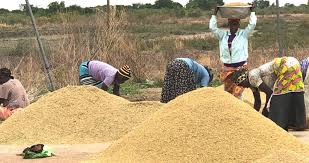Africa faces dire food shortage amid conflicts, drought, corruption, inflation
By Jeph Ajobaju, Chief Copy Editor
Russia’s unprovoked war against Ukraine is combining with conflicts, political instability, and the pandemic to stoke food prices in Africa amid low purchasing power caused by bad governance, corruption, and inflation.
Up to 350,000 children are already facing starvation with their lives on the line in Somalia neck deep in its worst drought in decades, apart from its usual reasons for begging bread along with Ethiopia and Sudan, such as conflicts and wars.
Nigeria has the highest malnutrition rate in Africa, and the second highest in the world, with about 17 million of its children “undernourished”, which results in them being “stunted and/or wasted,” says the United Nations Children’s Fund (UNICEF).
Millions more from among the 1.2 billion population on the continent are expected to swell the ranks of the malnourished in a matter of a few weeks.
The March 2022 analysis of the Cadre Harmonisé, published by the Integrated Food Security Phase Classification (IPC), says 38.3 million people will experience a food and nutrition crisis between June and August, an increase of 40.2 per cent from 27.3 million during the same period in 2021.
Based on projections for June-August 2022, the estimated number of people in phases 3 to 5 in the most affected countries is 19.5 million (Nigeria), 3.5 million (Burkina Faso), 4.4 million (Niger), 2 million (Chad), and 1.8 million (Mali).
Food prices have soared at unprecedented levels, coupled with low purchasing power.
Maize (+30 per cent), millet (+26 per cent), sorghum (+24 pe cent), and rice (+18 per cent) have seen price increases over the past five years in West Africa, according to Cadre Harmonise.
Adele Khodr, UNICEF Regional Director for the Middle East and North Africa, added that the number of malnourished children is likely to drastically increase in the coming years.
The population of West Africa is on track to quadruple from its current 0.9 billion to 3.9 billion people by 2100.
The United Nations Food and Agriculture Organisation (FAO) reports that more than a quarter of Sub-Saharan Africa’s population currently suffers from undernutrition, and the region imports about 20 per cent of its staple calories.
_________________________________________________________________
Related articles:
Nigeria has highest malnutrition rate in Africa, second highest globally
Abuja spends N1b daily, N100 per child on school feeding
Parents struggle to educate children amid rising costs
Buhari votes N72b for killer Fulani herdsmen. Northern IDPs scavenge for food in markets
__________________________________________________________________
Russian/Ukrainian war
Up to 30 per cent of global wheat is produced by Russia and Ukraine put together. Low-income and food-deficit countries buy a lot of it because it is the cheapest.
Africa imports half its wheat from Russia and Ukraine, said Cadre Harmonise, per reporting by Nairametrics.
Global wheat prices rose 19 per cent on 22 March, a month after Russia invaded Ukraine on 24 February.
Ukraine was the UN World Food Program’s biggest supplier of food in 2021.
Besides staple food commodities, Russia and Ukraine also produce and supply cheaper fertilizer and oil compared to other countries.
According to the Food and Agriculture Organisation (FAO), the food price index was 159.3 points in March compared to a revised 141.4 points in February.
The February figure was previously recorded at 140.7, much higher than the March figure, which spiked higher, a record at that time.
As a result of the unplanned aggression by Russia, Ukraine’s exports of sunflower oil, corn, barley, and wheat have been halted.
The FAO warned food and feed prices could rise by as much as 20 per cent due to the conflict in Ukraine, pushing people at risk of malnutrition.
Aside from the disruption of production caused by the war, the blockage of the Black Sea region’s agricultural supplies drove up food prices even further.
High fertilizer prices
In sub-Saharan Africa, where small-scale farmers rely largely on imports – if they even use extra nutrients at all – a surge in fertilizer prices is increasing food security concerns.
Fertilizer prices have tripled over the past 18 months, and many farmers are considering skipping purchases this year.
A market whose growth potential has been touted for years is set to shrink by almost a third, said Sebastian Nduva, program manager at AfricaFertilizer.Org.
“This could reduce cereal production by 30 million tons, enough to feed 100 million people,” he added.
Solutions
Nairametrics writes that investment in agriculture and food systems must be a priority for African leaders, from both economic and security perspectives.
Agriculture has reduced poverty 11 times more effectively than any other sector in Africa. Besides, if Africa prioritises investment in youths, its economy could reap an additional $500 billion annually.
Domestic producers and consumers
African governments need to place a greater emphasis on protecting the economic and social interests of domestic producers and suppliers.
They facilitate trade, but protecting the most vulnerable is a social responsibility that needs to be more prominent. Globalisation cannot mean the destruction of local markets.
Better storage facilities
Local farmer cooperatives can reduce waste by building, owning, and operating community silos.
Africa loses between 20 per cent and 40 per cent of its agricultural production due to transportation. Close-to-farm storage facilities are important for increasing overall stocks.
Pan African partnership
Ecosystem monitoring and assessment programmes can be conducted jointly in different countries so that high-quality, integrated information is available to help with decision-making.
It is possible to share and implement best agricultural practices across countries to accelerate capacity building.
A country’s management practices may affect the ecosystem services and food security of other countries.
Coordinating adaptation planning at the regional level allows multiple stakeholders to make joint decisions, assess trade-offs, and reconcile multiple objectives.











